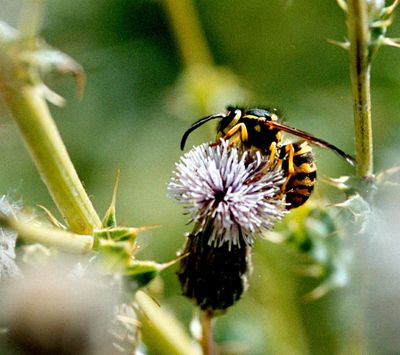Expert sees drop in yellow jackets
Reason for rise and fall in wasps’ numbers unclear

Spokane photographer Nick Follger was shooting photos at two recent outdoor weddings when he noticed something odd.
No yellow jackets.
“Usually you have to worry about them, especially around tables holding lots of food. The yellow jackets usually consider the food as one big feast,” Follger said.
Follger and his wife, Michele, have also enjoyed more meals outdoors on their deck uninterrupted by the swarms of yellow jackets they usually see at this time of year.
The Follgers’ impressions are supported by the observations of Peter Landolt, one of Washington’s foremost insect researchers: This year is not a big year for yellow jackets.
That doesn’t mean yellow jackets will be scarce between now and November, Landolt warned. And his conclusion isn’t shared by another research entomologist in Spokane Valley who works for bug-trap manufacturer Sterling International.
But Landolt, one of eight U.S. Agriculture Department insect researchers based in Yakima, estimates the regional yellow jacket population will be 70 to 80 percent below normal this year.
“The easiest explanation is the drawn-out wet and cool spring,” which could have killed yellow jacket queens when they became active in March and April as they began looking to make nests, he said.
Qing-He Zhang, a research entomologist working for Sterling International, contends dry summer weather canceled out the wet spring, creating a boom year for yellow jackets.
“I am expecting even higher numbers of these social wasps during September and October,” Zhang said.
Sterling manufactures a line of baited traps under the Rescue brand. Sales of yellow-jacket traps have increased this year, said Jim Oxley, the company’s vice president of sales.
While yellow jackets can be a nuisance around picnics and parties, they also have positive benefits. They love to eat caterpillars and smaller insects, for example.
The state crop most likely to benefit from the fall-off is wine grapes, Landolt said. Fewer yellow jackets means fewer grapes nibbled on and ruined.
“They bite into grapes, and the cuts and openings allow mold to start in the fruit,” Landolt said.
Identifying yellow jackets can be tricky, since they resemble hornets and bees.
All yellow jackets are a type of wasp, a term that also covers hornets.
They’re the same size – a half-inch long – as bees. But yellow jackets don’t have dense tan-brown hair on their bodies and don’t have flattened hairy hind legs like bees do.
Hornets and yellow jackets are close in size, but hornets have larger heads.